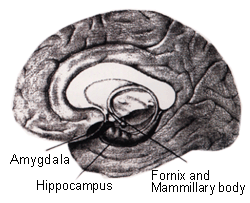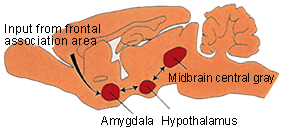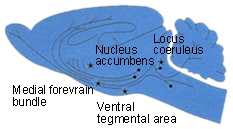  |
 |
 |
Dr. Hiroaki Niki
Head, Laboratory for Neurobiology of Emotion |
 |

|
The Quest for the Mechanisms of Emotion
|
 |
What are Emotions? |
|
We cannot imagine life without emotions. There are many views about scientific understanding of emotions. "JODO" is the translated Japanese of English word "emotion". In Japan the term "JODO" is not popular in the everyday life and "KANJO" ("feeling" or "affect") is more popular.
|
 |
The term "JODO" was originally a psychological term. Previously, the same English word of 'emotion" was translated as "JOCHO" in Japanese.
For example, "JOCHO" is used in such a daily expression as "JOCHO FUANTEI" ("emotional instability"), but the same word "JOCHO" also means "mood", like "SHITAMACHI JOCHO" ("downtown atmospheres"). Consequently, it has been realized to be inappropriate for expressing vigorous dynamic process such as fear and anger. That is why "JOCHO" was replaced by "JODO" in the Japanese translation of English word "emotion". Then, why do we use the term "emotion" instead of feeling in the field of science ? Those feelings such as, fear, anger, sorrow, and pleasure include both covert (subjective) and overt (objective) aspects: the former process can be felt and understood only by the person experiencing them while the latter is observable by the other people. We can know the latter aspects through changes in activities of the autonomic nervous system (i.e., increase in heart rate) and other bodily changes (changes in facial expressions and muscular tension). Thus, when we study feeling scientifically and attempt to explain it scientifically based on the results of animal experiments, we should inevitably examine "emotion", which belongs to a hierarchically lower level than feeling.
Charles Darwin who pioneered evolutionary theory described in his book "The Expression of the Emotions in Man and Animals" that some emotional expressions are similar among cats, dogs, monkeys including humans. Thus, he provided a basis for discussing the emotions and feelings of humans based on animal experiments. Of course, we cannot explain everything about human emotions by studying animals. Darwin interpreted the emotions as faculties which help living animals to take proper countermeasures in emergencies in order to increase the probability of survival. This means, in the other words, the biological significance of emotions lies in achieving the survival of individuals and the preservation of the species.
Both man and animals feel fear for enemies and harmful events, and try to escape from them. On the other hand, they show approach (seeking) behavior to those events that satisfy their desires (pleasant emotion). When the fulfillment of the desire is obstructed, anger is provoked and they display aggression. In this way, emotions drive man and animals to actions. It is postulated that such adaptive behavior occurs depending on the process of evaluating the biological significance of stimuli (harmful or not) from the environment.
|
 |
 |
Emotions and Brain |
 |
|
How and in what ways have the brain mechanisms of emotions been investigated ?
Ablation method destroying a specific brain region, stimulation method stimulating a specific brain region, and recording method recording the neuronal activities from the brain have been employed in animal studies on emotions and brain. In addition, the technique measuring various neurotransmitters controlling emotions has also been used. Gene knockout technique is a recent new method to study the relationship between specific genes and brain functions.
|
|
In human studies Positron Emission Tomography (PET) and functional Magnetic Resonance Imaging (fMRI) techniques have been applied to researches on emotion. Although a variety of techniques have been applied to studies on emotions and brain, the mechanisms of emotions still remain an impregnable fortress due to their complexities and the breadth of unexplored fields.
Which part of the brain is involved in emotion? MacLean proposed in late forties that the limbic system, a phylogenetically old brain area, is the visceral brain as well as the emotional brain.
|
-
|

Fig. 1 Location of Amygdala in Human Brain
|
|
It has been well documented that the amygdala in the limbic system (Fig. 1) plays an essential role in emotion, and that the hypothalamus and the midbrain central gray are also involved in the expression of emotion. Thus, the neural system formed by the amygdala-hypothalamus-midbrain central gray is now considered to be the brain region involved in emotion. As the region controlling the amygdala-hypothalamus-midbrain central gray system from a higher level, the frontal association area should be taken into accounts. It has also been made clear that the regions related to fear and anger are clearly segregated each other within the amygdala. The same is the case in the hypothalamus and in the midbrain central gray.
|
 |

Fig. 2 Brain Regions Involved in Emotion
( Fear, Anger )
|
-
|
While unpleasant emotion such as fear has long been extensively studied, it was in 1954 that the existence of pleasure center in the brain was found by Olds and Milner. At present it is known that the main regions for pleasure include the locus coeruleus, the ventral tegmental area, the medial forebrain bundle (lateral hypothalamus) and the nucleus accumbens (Fig. 3).
|
 |
|
We will also start a new project on pleasure, using μ-opioid receptor knockout mice and dopamine transporter knockout mice.
|
 |
Quite recently, we have discovered that fyn is also involved in alcohol sensitivity. Our findings indicate that fyn-deficient mice have a higher sensitivity to alcohol and do not have a transient tolerance to alcohol, and that the hyper-sensitivity to alcohol of fyn-deficient mice is related to an abnormality in the function of NMDA receptor.
|
-
|

Fig. 3 Brain Regions Involved Pleasure (*)
|
 |
|
These experiments on alcohol sensitivity may not seem to be related to the research on emotions at a glance, but we believe that they can be classified as animal studies related to human violence resulting from alcohol drinking or to the mechanisms of alcohol addiction.
Passion and reason have been separated traditionally, but minds without emotions are not actually minds at all. Although a cognitive neuroscience is now popular, there are relatively few neuroscientists engaged in the field of affective neuroscience (studying emotions and brain). The current "fin de siecle" social milieu seems to be producing anxieties and frustrations among people, increasing their stress as well as causing emotional disorders and psychosomatic diseases at the individual level, and also increasing school violence, family violence and drug-addiction at the social level. In such a situation, we do hope that the importance of researches on emotions is recognized by as many researchers as possible, and affective neuroscience will progress.
|
 |
 |
 |
|
|
|






